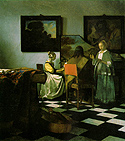
Retired FBI special agent Robert K. Wittman led the agency’s Art Crime Team and is the author of “Priceless: How I Went Undercover to Rescue the World’s Stolen Treasures’’ (Crown).
http://www.boston.com/ae/theater_arts/articles/2010/07/23/robert_k_wittman_and_the_art_of_undercover_work/
Q. You spent two years trying to locate the paintings stolen from the Isabella Stewart Gardner Museum in 1990. Will that crime ever be solved and the artwork returned?
A. I think the paintings will be recovered. However, in many cases we never find out who the thieves were. Several Norman Rockwell paintings were stolen in Minneapolis and recovered in Rio de Janeiro, for example, and I still don’t know who stole them. The important thing always is to get the paintings back.
Q. Best guess where the Gardner Museum paintings are?
A. The south of France or Spain.
Q. Many potential culprits have surfaced over the years, including Whitey Bulger. Ever come close to crossing paths with Whitey?
A. No. There’s a lot of folklore surrounding this case that I never gave much credence to, either.
Q. If artwork this valuable is so hard to sell, why do thieves keep stealing it?
A. How many big art thefts have there been in the US recently? Not many. Fraud cases and forgeries, yes. But it’s a different story in Europe, where other legal systems come into play.
Q. Also less security?
A. To some degree, but that still begs the question: Why steal this stuff? To make money, of course, which is why I say the real art to art theft is not the stealing, it’s the selling. These guys are usually good crooks but terrible businessmen. Especially in Europe, though, thieves also use stolen artwork as bargaining chips.
Q. As in, I’ll trade you this missing Picasso for a lighter sentence in a drug case?
A. Exactly. In the US, we can’t negotiate like that.
Q. As an undercover agent, what’s the hairiest situation you found yourself in?
A. My biggest moments of terror were when I thought the bad guys had figured things out and we weren’t going to get the artwork back. Personal danger? That’s something cops and agents accept every day. I worried more that I’d said something wrong and lost a shot at closing the deal.
Q. You had a hand in recovering over $225 million in stolen art and antiquities. Proudest moment?
A. Recovering the Rembrandt self-portrait stolen from the Swedish National Museum — it was valued at $36 million — was great, because we’d just formed the Art Crime Team and that case gave us a big push. It’s not always about the money, though. I recovered a Civil War banner carried into battle by one of the country’s first African-American regiments. At least five soldiers died carrying it, which makes its historical value priceless.
Q. With your book out, you’ve become pretty recognizable. So, no more undercover work?
A. I don’t do that anymore, no, which has actually been a big relief. But I do help others do it.
Interview was condensed and edited.
Joseph P. Kahn can be reached at jkahn@globe.com.
Despite the negative spin by some within the FBI and other Govt Agencies, Robert Wittman has secured a special place in the hearts of the American People.
His story is one of true grit, selfless determination and reflected in an honest, humble manner.
There are so many negative things about the FBI and other Govt agencies Robert Wittman could have said, been justified in saying, and most of us lesser mortals would have said.
However, integrity intact, Robert Wittman walked the fine line and has established himself as Standing on the shoulders of Giants.
In the not too distant future it will be revealed just how "straight as a gun barrel" Robert Wittman was in his career, via a court case concerning the recovery of two world famous stolen paintings.
Then we will never "Forget Paris"
More to follow.............................

No comments:
Post a Comment